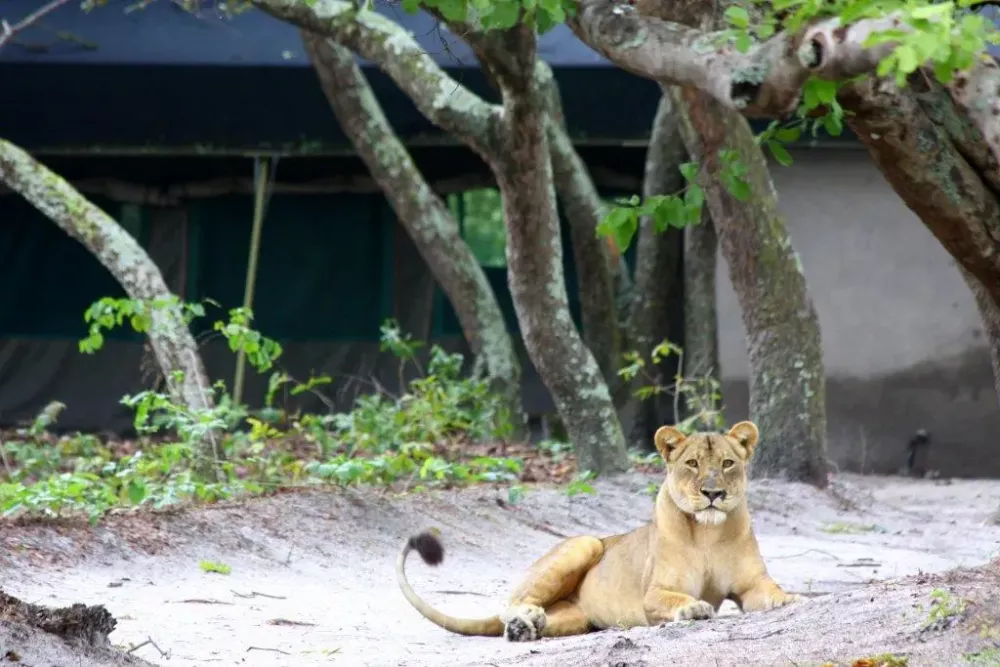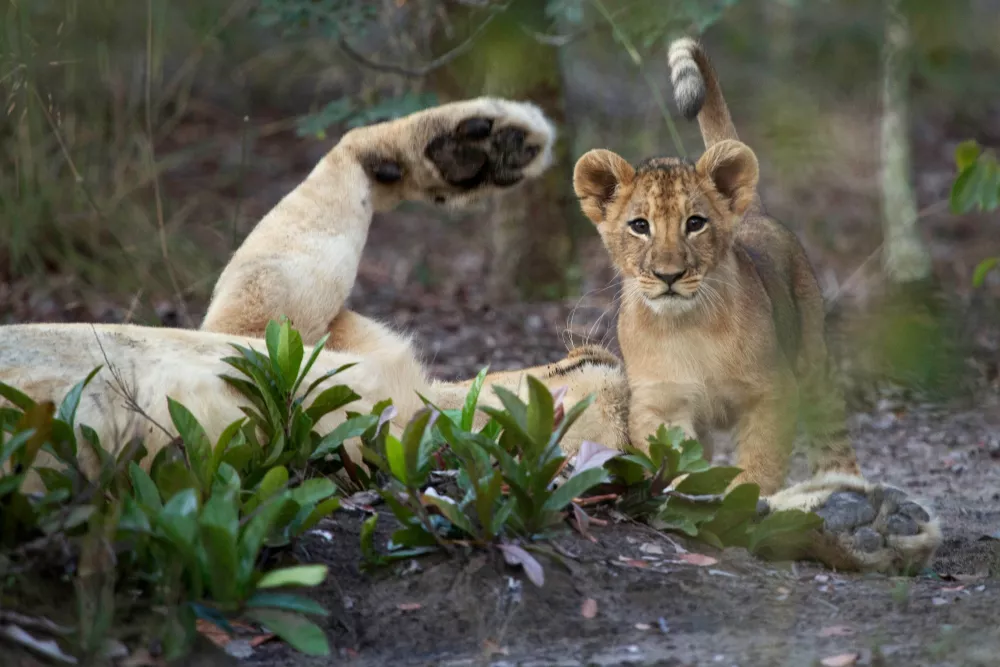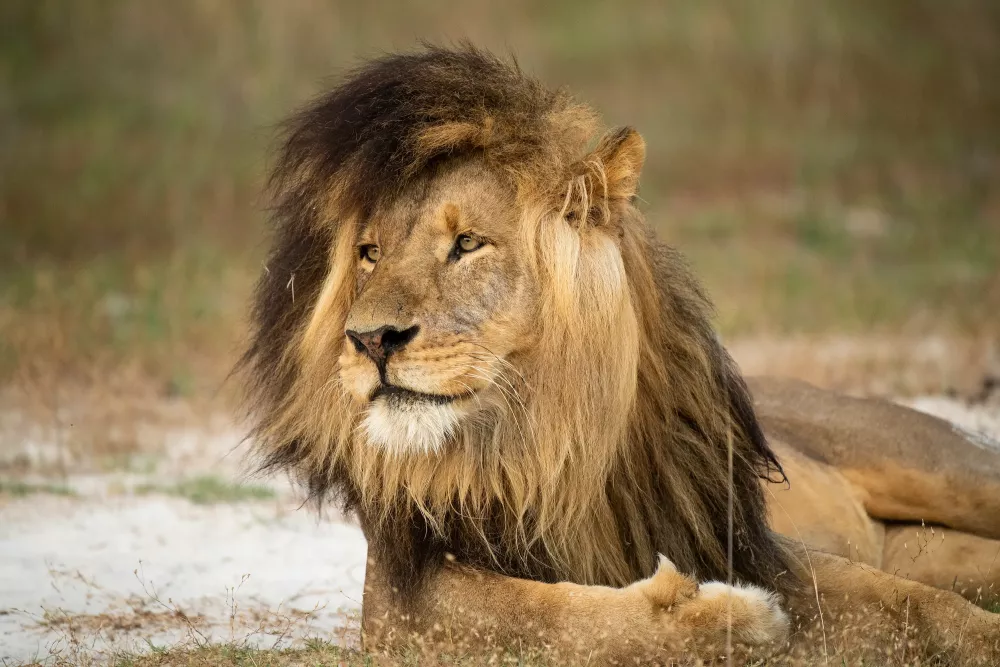Over the past twenty years African Parks has assumed the responsibility of protecting lions in 16 of the 22 parks across 10 countries. Of these lions, one in particular has a story that we will never forget – the story of Lady Liuwa.
By the 1990s, lions in Liuwa Plain National Park in Zambia had all but been eradicated, thanks to poaching, illegal trophy hunting and human wildlife conflict retaliation – all, except for one. First discovered in 2002, Lady Liuwa, roamed the plains of Liuwa in solitude for years, and having to exist as a lonely lioness, she looked to humans for companionship.
“The first time I encountered Lady, she had grown accustomed to people and was completely unafraid, often coming to within a few meters of people in camp. Lady spent most of her time in the southern parts of Liuwa, around the woodlands of Matiamanene Camp and liked to lie near the camp fire, next to your room or even on the veranda of your tent!” explained African Parks member, Andrea Reid, who lived in Liuwa Plain National Park from 2007 to 2009.
Distinctive by a dark spot on her left muzzle below her nose, Lady, as she was affectionately known, was described sometimes as regal but also as a gentle lioness, merely wanting the company of others.
Sharing his experiences with the lioness, previous park manager of Liuwa Plains, Rob Reid said: “She didn't look at you like a lion - there was none of that bone chilling stare, head held high, alert ‘through you’ sort of look. She would give you a sort of gentle tilted head view, a relaxed and familiar pose. A look that had seen it all, and been through thousands of nights of loneliness.”

Ending the Era of a Lonely Lioness
It was clear that something needed to be done, not only to find Lady Liuwa a companion, but also to replenish lion numbers in Liuwa National Park so that predator balance could be restored to the park’s ecosystem.
Liuwa’s history dates back to the 19th century when the King of Barotseland, Lubosi Lewanika, appointed his people as custodians of the landscape, of which over 12, 000 legally live within the park. For the lion reintroduction to be a success it needed the support of the Lozi people, and it was only after this was gained that efforts to find Lady Liuwa a mate could be put in place.
With this support, together with that of the Barotse Royal Establishment and the Department of National Parks and Wildlife, African Parks secured plans to translocate a male lion from Kafue National Park in 2008. However, the male did not make the translocation process and sadly died shortly after his arrival in the park due to what is believed to be a reaction to the sedative medication. To ensure that lessons were learnt from the first failed attempt, park management undertook an in-depth assessment of the translocation method and after revising the process, two more males were sourced from Kafue in 2009. It was decided that bringing in two lions at once would be beneficial as having each other’s company would have a calming effect. The transport method for this second introduction was revised so that the lions could safely wake up en route without having to be sedated for extended time periods, and the seasonal timing of the introduction was changed to the middle of the wet season, when Liuwa has abundant prey species. As a result, the two males were successfully introduced to Liuwa. Within a day of their arrival, Lady accepted her new companions and the three formed a close unit, moving together across the plains. Although it was expected that she would produce cubs shortly after the males’ arrival, she never did and it was believed that after living in solitude for so long, she had become infertile.

A New Generation Emerges
In 2011, two young lionesses were introduced in the hope that a small pride could be formed and Liuwa’s lion population could begin to grow. But a year later one of the females was killed by a poacher’s snare and the other, Sepo, fled towards the Angolan boundary. In a dramatic rescue mission, Sepo was darted, flown back to the park by helicopter and placed in a boma for safety - along with Lady Liuwa to encourage bonding, critical for the young lioness' survival. Thankfully this was successful and after two months, both lionesses were released back into the park, and from then on were inseparable. Shortly thereafter, Sepo produced her first litter of cubs.
The growing pride suffered another setback when the two males left the park and entered Angola. One was sadly shot and killed by villagers, but the other fled back to safety in Liuwa. In 2016, in collaboration with the Zambia Carnivore Programme (ZCP) and Mushingashi Conservancy, African Parks introduced another male lion to help grow the pride and increase genetic integrity. The newly translocated male and the resident male were placed in a boma to undergo a bonding process before being released into the park two months later to join the females. While the males were in the enclosure, Lady Liuwa and Sepo visited them, sleeping nearby and staying close during the day. Later that year, Sepo produced another two new cubs, sired by the resident male. While Lady Liuwa could not have cubs of her own, she was regularly seen helping raise Sepo’s numerous litters, and it was clear that finally Lady Liuwa had a pride of her own.
Lady Liuwa’s exact age is unknown when she died in 2017 of natural causes, but it is believed she was 17 years old, an extraordinarily long life for a wild lion hunting and surviving so long on her own.
Today Liuwa’s lion population continues grow with 16 individuals now living in the park.

Africa's Lions Today:
- Aproximately 24,000 wild lions remain in Africa today, with recent studies showing that lion populations have declined by 75% since 1970s.
- The main threats to lion are the illegal trade in lion bones and parts, habitat loss and fragmentation and human-wildlife conflict.
- African Parks holds some of Africa’s most important lion strongholds including populations in Kafue National Park in Zambia, remaining numbers of endangered northern lions in Chinko, Central African Republic, and a population of critically endangered West African lion in Pendjari National Park in Benin.
- Through strong community engagement and development projects, Africa Parks has significantly contributed to reducing human-lion conflict in the parks it manages.
- Together with collaborating partners in lion range land, African Parks is a reliable contributor of information to the IUCN regarding the conservation status of lion, in particular for northern and western lion populations found in central and West Africa.
10 August 2023 – Melissa Reitz, African Parks
Your Support Goes a Long Way
At African Parks we are working everyday to protect Africa's last wild landscapes. By donating to us, you are making a difference and are giving hope to people and wildlife across the continent.
Donate